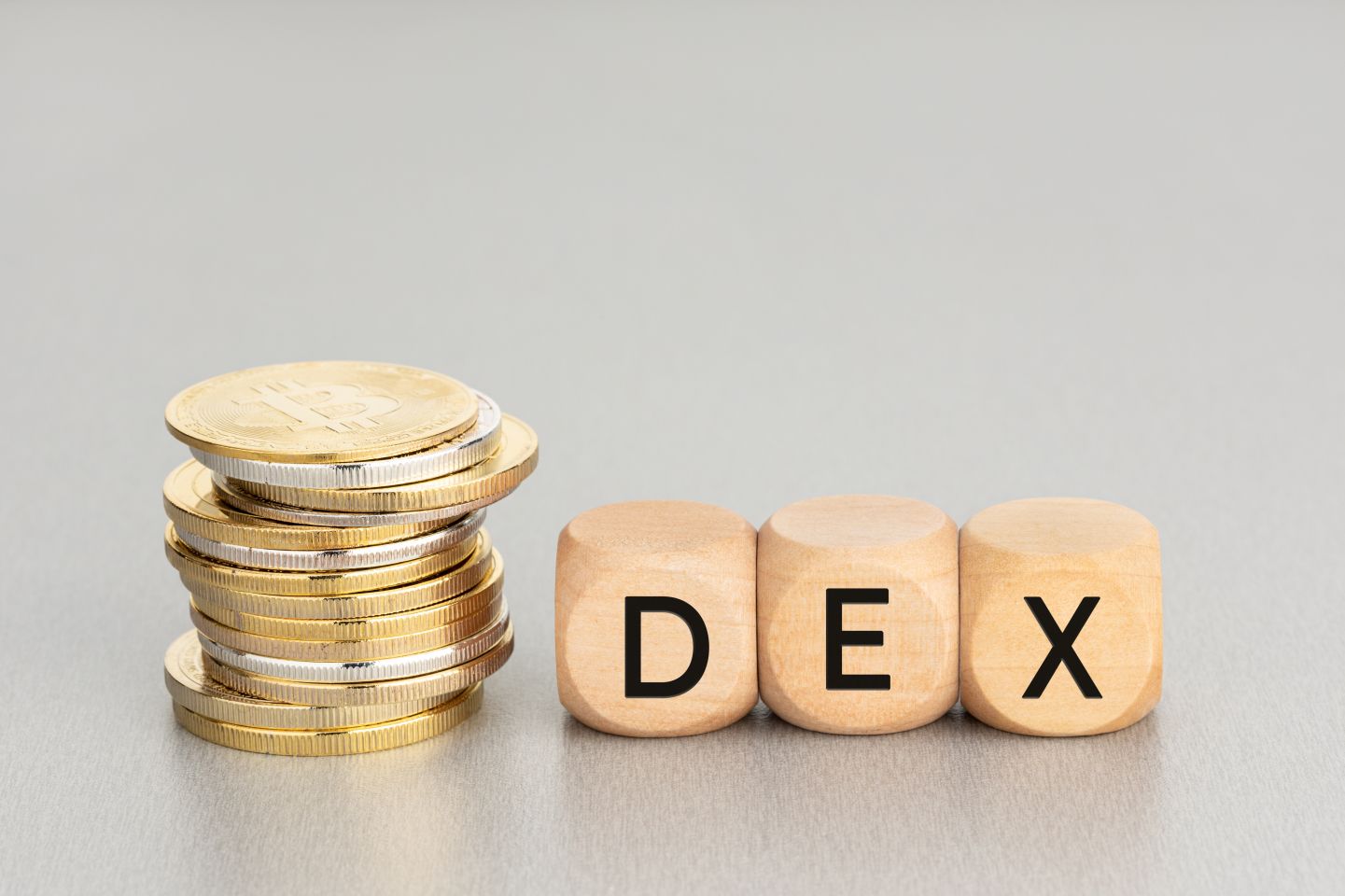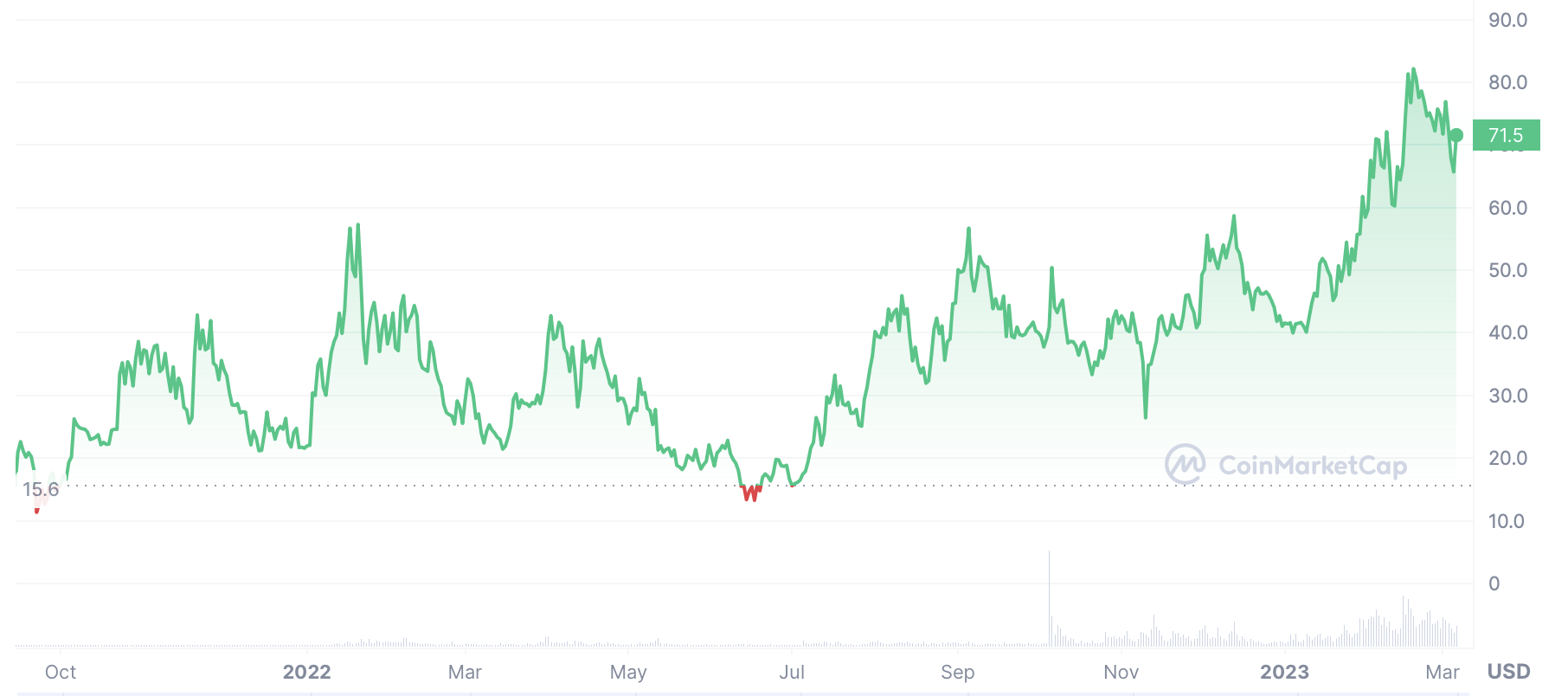GMX price prediction: What is GMX?
Can GMX stand apart from other DEXes?
It is the native token of a decentralised exchange, but what is DEX, and what makes it stand out in an increasingly crowded market? Let's take a look and see if we can also examine some of the GMX price predictions that were being made on 6 March 2023.
What is GMX?
GMX is a decentralised exchange (DEX) that provides spot and perpetual listings while offering users leverage, or the ability to borrow money in order to invest it or trade with it. Its main selling points are its low swapping fees and “zero price impact trades”.
The DEX functions through a multi-asset liquidity pool. Those providing liquidity can earn fees from those trading. These fees are applied to swaps, leverage trading, market making and asset rebalancing.
As well as attracting providers, GMX is hoping its exchange product is enough to bring in users. Along with its low fees, it has implemented the Chainlink (LINK) oracle to bring “dynamic pricing” to the DEX. Its platform also “uses an aggregate price feed which reduces the risk of liquidations from temporary wicks”.
GMX was also available on the Avalanche (AVAX) blockchain and Arbitrum, a platform based on Ethereum (ETH).
Dual token system
The exchange is powered by a dual token mechanism. The GLP cryptocurrency is the liquidity token, and can be used for trading index assets. Investors can mint GLP by using any index asset, or burn the token to redeem an asset. A total 70% of swap and leverage trading fees are distributed to GLP holders.
The GMX cryptocurrency is the platform’s utility and governance token. The remaining 30% of fees are distributed to those staking the coin. Arbitrum users will receive their rewards in ether (ETH) and Avalanche investors will gain AVAX yield.
As well as staking, investors can utilise their GMX to have a say over the future direction of the DEX. For example, a recently passed proposal increased the exchange’s maximum leverage to 50 times.
Another thing to point out is that, because GMX is based on the Avalanche and Ethereum blockchains, it is a token, rather than a coin. You might see references to such things as GMX coin price prediction, but those references are wrong.
GMX’s volatile past performance
GMX to USD price chart

Source: CoinMarketCap
Let's now take a look at some of the GMX price history. While past performance should not be taken as an indicator of future results, knowing what the token has done in the past can help give us some context if we want to either examine a GMX price prediction or else make one of our own.
The GMX cryptocurrency has had a volatile history, with plenty of price surges. It went live on 14 September 2021 with an opening price of $14.99 and saw an initial rally until it peaked at $40.05 on 30 October.
The cryptocurrency soared even higher the following month. Its trading volume exceeded $5bn on 13 November 2021. It then added support for the magic internet money (MIM) stablecoin on 16 November. The same day, GMX rocketed to its all-time high of $217.32.
GMX was unable to maintain this valuation and it closed the year at $21.96. But it was not long before another breakout.
The token managed to defy the wider bear market at the end of January 2022 after a GMX and AVAX pair was listed on the Trader Joe exchange, along with a GMX crypto farm. The exchange also made it easier to trade between Arbitrum and Avalanche versions of the GMX token that month with the Synapse protocol.
GMX next climbed to a high of $61.35 on 20 January 2022, but closed the day at $49.04. The large price swings continued throughout this year. It fell to a low of $20.70 on 15 March, before climbing back to $38.26, the daily low on 1 April 2022.
It plummeted even further on 18 June as it stooped to an intraday low of $12.65. This mirrored a wider bearish trend in the crypto market.
However, the token showed strong signs of recovery in recent months. It reached a high of $62.19 on 5 October 2022, after its listing on Binance and the community's vote to add the GMX token on the FTX cryptocurrency exchange.
Despite an initial shock to the GMX crypto, the later downfall and bankruptcy of FTX spelled good news for the decentralised exchange. After the FTX blowout, crypto investors migrated en masse away from centralisation. Decentralised exchanges, including GMX, subsequently saw greater trading volume.
On 28 November 2022, Delphi Digital reported that the GMX exchange had earned more than $1m in trading fees, overtaking its rival, the industry giant Uniswap.
After falling to a 90-day low of $25.60 on 9 November with the wider crypto market, the GMX token had a bullish upward trajectory and on 13 December the token hit $60.06, falling to close the year at $41.57, representing a rise of nearly 90% over the course of a year where the overall crypto market was down by more than 60%.
However, by 8 January, it was trading at a low of $41.13. After an announcement on Twitter by Arbitrum, congratulating GMX for surpassing $100M on total fees, the token saw a minor rally which became a pretty important one as the market became bouyant and the token reached a high of $84.63 on 16 February. After that, it fell down somewhat and, on 6 March 2023, it was worth about $71.50. At that time, there were 8,519,843 GMX in circulation out of a total supply of 8,988,537.
GMX price prediction round-up
Let's now take a look at some of the GMX price predictions that were being made as of 6 March 2023. Keep in mind that price forecasts, especially for something as potentially volatile as crypto, are very often wrong. Also, keep in mind that many long-term crypto price predictions are made using an algorithm, which can change at a moment's notice.
First, CoinCodex had a fairly gloomy short-term GMX price prediction for 2023, suggesting that the token could fall to $62.63 by 11 March before recovering a little to $65.66 on 5 April. The site's technical analysis was, perhaps surprisingly, bullish, with 23 indicators making positive signals compared to just five making bearish ones.
DigitalCoinPrice believed the coin could reach an average of $143.96 this year. Its GMX price prediction for 2025 suggested the token could reach an average of $241.78, and could then climb to $736.97 in 2030 before potentially breaking past the $1,000 barrier to stand at $1,024.27 in 2030.
PricePrediction made a GMX crypto price prediction which anticipated the coin could climb from $97.25 this year to $205.36 in 2025. Its GMX price prediction for 2030 said the token could climb past $1,000 to trade at $1,355.82 before potentially hitting $2,807.77 in 2032.
Wallet Investor also had an upbeat GMX price forecast, suggesting that it could get to $109.35 by early March 2024 and to just over $275 in five years time.
When considering a GMX token price prediction, it is important to keep in mind that cryptocurrency markets remain extremely volatile, making it difficult to accurately predict what a coin or token’s price will be in a few hours, and even harder to give long-term estimates. As such, analysts and algorithm-based forecasters can and do get their predictions wrong.
If you are considering investing in cryptocurrency tokens, we recommend that you always do your own research. Look at the latest market trends, news, technical and fundamental analysis, and expert opinion before making any investment decision. Keep in mind that past performance is no guarantee of future returns, and never trade with money that you cannot afford to lose.
FAQs
Is GMX a good investment?
It is hard to say. A lot will depend on whether GMX can outperform the market, and how well that market does as a whole, too.
In volatile cryptocurrency markets, it is important to do your own research on a coin or token to determine if it is a good fit for your investment portfolio. Whether the GMX token is a suitable investment for you depends on your risk tolerance and how much you intend to invest, among other factors.
Keep in mind that past performance is no guarantee of future returns, and never invest any money that you cannot afford to lose.
Will GMX go up or down?
No one really knows for sure. Keep in mind that price predictions often turn out to be wrong, and that prices can, and do, go down as well as up.
In volatile cryptocurrency markets, it is important to do your own research on a coin or token to determine if it is a good fit for your investment portfolio. Whether GMX is a suitable investment for you depends on your risk tolerance and how much you intend to invest, among other factors.
Keep in mind that past performance is no guarantee of future returns, and never invest any money that you cannot afford to lose.
Should I invest in GMX?
Before you decide whether or not to invest in GMX, you will have to do your own research, not only on GMX itself, but on other DEX-related coins and tokens. .
Whether you should invest in GMX is a question that you will have to answer for yourself. Before you do so, however, you will need to conduct your own research. Never invest more money than you can afford to lose, because prices can go down as well as up